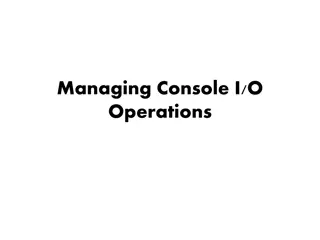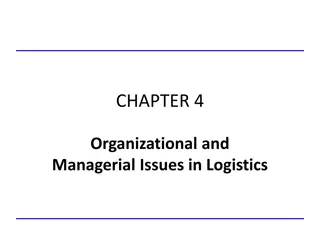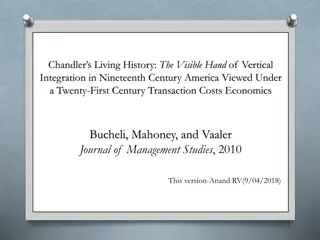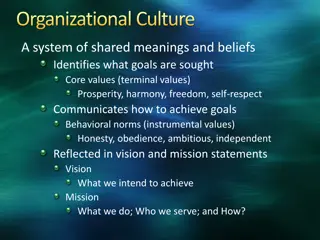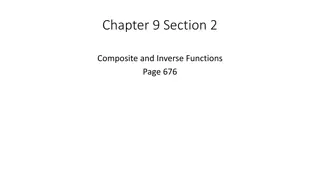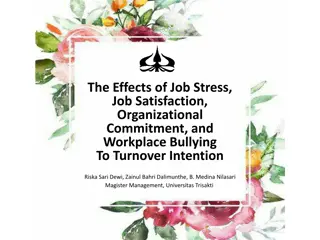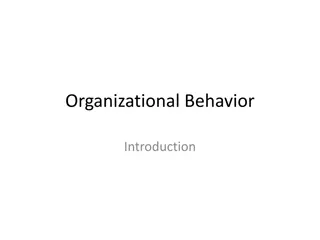Understanding Operations Management and Organizational Functions
Operations Management involves creating value through the transformation of inputs into goods and services. Essential organizational functions like marketing, production, finance, and accounting contribute to the efficient production of goods and services. Various industries utilize organizational charts to visualize the structure and functions of their operations, such as in commercial banking, airlines, and manufacturing sectors.
Download Presentation

Please find below an Image/Link to download the presentation.
The content on the website is provided AS IS for your information and personal use only. It may not be sold, licensed, or shared on other websites without obtaining consent from the author. Download presentation by click this link. If you encounter any issues during the download, it is possible that the publisher has removed the file from their server.
E N D
Presentation Transcript
Meet the Professor Meet the Professor Dr. Abe Harraf, Professor Monfort College of Business University of Northern Colorado Greeley, Colorado
What Is Operations Management? Production is the creation of goods and services Operations management (OM) is the set of activities that creates value in the form of goods and services by transforming inputs into outputs
Organizing to Produce Goods and Services Essential functions: Marketing generates demand Production/operations creates the product Finance/accounting tracks how well the organization is doing, pays bills, collects the money
Organizational Charts Commercial Bank Operations Teller Scheduling Check Clearing Collection Transaction processing Facilities design/layout Vault operations Maintenance Security Finance Investments Security Real estate Marketing Loans Commercial Industrial Financial Personal Mortgage Accounting Auditing Trust Department Figure 1.1(A)
Organizational Charts Airline Operations Ground support equipment Maintenance Ground Operations Facility maintenance Catering Flight Operations Crew scheduling Flying Communications Dispatching Management science Finance/ accounting Accounting Payables Receivables General Ledger Finance Cash control International exchange Marketing Traffic administration Reservations Schedules Tariffs (pricing) Sales Advertising Figure 1.1(B)
Organizational Charts Manufacturing Operations Facilities Construction; maintenance Production and inventory control Scheduling; materials control Quality assurance and control Supply-chain management Manufacturing Tooling; fabrication; assembly Design Product development and design Detailed product specifications Industrial engineering Efficient use of machines, space, and personnel Process analysis Development and installation of production tools and equipment Finance/ accounting Disbursements/ credits Receivables Payables General ledger Funds Management Money market International exchange Capital requirements Stock issue Bond issue and recall Marketing Sales promotion Advertising Sales Market research Figure 1.1(C)
Why Study OM? OM is one of three major functions (marketing, finance, and operations) of any organization We want (and need) to know how goods and services are produced We want to understand what operations managers do OM is such a costly part of an organization
What Operations Managers Do Basic Management Functions Planning Organizing Staffing Leading Controlling
The Critical Decisions Service and product design What good or service should we offer? How should we design these products and services? Quality management How do we define quality? Who is responsible for quality? Table 1.2 (cont.)
The Critical Decisions Process and capacity design What process and what capacity will these products require? What equipment and technology is necessary for these processes? Location Where should we put the facility? On what criteria should we base the location decision? Table 1.2 (cont.)
The Critical Decisions Layout design How should we arrange the facility and material flow? How large must the facility be to meet our plan? Human resources and job design How do we provide a reasonable work environment? How much can we expect our employees to produce? Table 1.2 (cont.)
The Critical Decisions Supply-chain management Should we make or buy this component? Who are our suppliers and who can integrate into our e- commerce program? Inventory, material requirements planning, and JIT How much inventory of each item should we have? When do we re-order? Table 1.2 (cont.)
The Critical Decisions Intermediate and short term scheduling Are we better off keeping people on the payroll during slowdowns? Which jobs do we perform next? Maintenance Who is responsible for maintenance? When do we do maintenance? Table 1.2 (cont.)
Where are the OM Jobs? Figure 1.2
Where are the OM Jobs? Technology/methods Facilities/space utilization Strategic issues Response time People/team development Customer service Quality Cost reduction Inventory reduction Productivity improvement
Contributions From Human factors Industrial engineering Management science Biological science Physical sciences Information science
New Challenges in OM From To Local or national focus Batch shipments Low bid purchasing Global focus Just-in-time Supply chain partnering Rapid product development, alliances Mass customization Empowered employees, teams Lengthy product development Standard products Job specialization
Characteristics of Goods Tangible product Consistent product definition Production usually separate from consumption Can be inventoried Low customer interaction
Characteristics of Service Intangible product Produced and consumed at same time Often unique High customer interaction Inconsistent product definition Often knowledge-based Frequently dispersed
Industry and Services as Percentage of GDP 90 Services Manufacturing 80 70 60 50 40 30 20 10 0 UK France US Germany Russian Fed Czech Rep Mexico Japan Spain Canada China Australia Hong Kong South Africa
Goods Versus Services Attributes of Goods (Tangible Product) Attributes of Services (Intangible Product) Can be resold Can be inventoried Some aspects of quality measurable Selling is distinct from production Product is transportable Reselling unusual Difficult to inventory Quality difficult to measure Selling is part of service Provider, not product, is often transportable Site of facility important for customer contact Often difficult to automate Revenue generated primarily from the intangible service Site of facility important for cost Often easy to automate Revenue generated primarily from tangible product Table 1.3
Goods and Services Automobile Computer Installed carpeting Fast-food meal Restaurant meal/auto repair Hospital care Advertising agency/ investment management Consulting service/ teaching Counseling 25 | 100% | 75 | 50 | 25 | 0 | 50 | 75 | 100% | Percent of Product that is a Good Percent of Product that is a Service Figure 1.4
Development of the Service Economy 100 90 Services 80 70 60 50 40 30 Agriculture 20 10 0 1800 1850 1900 1950 2000 Figure 1.5 (A)
Development of the Service Economy 30 150 Industrial production 25 125 Manufacturing employment Employment (millions) Index: 1997 = 100 20 100 15 75 10 50 5 25 Estimate 0 0 1950 1970 1990 2010 Figure 1.5 (B)
Development of the Service Economy United States Canada France Italy Britain Japan W. Germany | | | | | 40 50 60 70 80 1970 2005 Percent Figure 1.5 (C)
New Trends in OM Past Causes Future Low-cost, reliable worldwide communication and transportation networks Global focus Local or national focus Batch (large) shipments Short product life cycles and cost of capital put pressure on reducing inventory Just-in-time shipments Low-bid purchasing Quality emphasis requires that suppliers be engaged in product improvement Supply- chain partners, Enterprise Resource Planning, e-commerce Figure 1.6
New Trends in OM Past Causes Future Shorter life cycles, Internet, rapid international communication, computer- aided design, and international collaboration Affluence and worldwide markets; increasingly flexible production processes Rapid product development, alliances, collaborative designs Mass customization with added emphasis on quality Empowered employees, teams, and lean production Lengthy product development Standardized products Job specialization Changing socioculture milieu; increasingly a knowledge and information society Figure 1.6
New Trends in OM Past Causes Future Environmental issues, ISO 14000, increasing disposal costs Environmentally sensitive production, green manufacturing, recycled materials, remanufacturing Low-cost focus Figure 1.6
Productivity Challenge Productivity is the ratio of outputs (goods and services) divided by the inputs (resources such as labor and capital) The objective is to improve this measure of efficiency Important Note! Production is a measure of output only and not a measure of efficiency
The Economic System Inputs Processes Outputs Labor, capital, management The U.S. economic system transforms inputs to outputs at about an annual 2.5% increase in productivity per year. The productivity increase is the result of a mix of capital (38% of 2.5%), labor (10% of 2.5%), and management (52% of 2.5%). Goods and services Feedback loop Figure 1.7
Productivity Units produced Input used Productivity = Measure of process improvement Represents output relative to input Only through productivity increases can our standard of living improve
Productivity Calculations Labor Productivity Units produced Productivity = Labor-hours used 1,000 = = 4 units/labor-hour 250
Multi-Factor Productivity Output Productivity = Labor + Material + Energy + Capital + Miscellaneous Also known as total factor productivity Output and inputs are often expressed in dollars
Measurement Problems Quality may change while the quantity of inputs and outputs remains constant External elements may cause an increase or decrease in productivity Precise units of measure may be lacking
Productivity Variables Labor - contributes about 10% of the annual increase Capital - contributes about 32% of the annual increase Management - contributes about 52% of the annual increase
Key Variables for Improved Labor Productivity Basic education appropriate for the labor force Diet of the labor force Social overhead that makes labor available Maintaining and enhancing skills in the midst of rapidly changing technology and knowledge
Labor Skills About half of the 17-year-olds in the US cannot correctly answer questions of this type Figure 1.8
Investment and Productivity in Selected Nations 10 Percent increase in mfg productivity Japan 8 Belgium Netherlands 6 Italy France 4 Canada US UK 2 0 10 15 20 25 30 35 Percentage investment
Service Productivity Typically labor intensive Frequently focused on unique individual attributes or desires Often an intellectual task performed by professionals Often difficult to mechanize Often difficult to evaluate for quality
Ethics and Social Responsibility Challenges facing operations managers: Developing safe quality products Maintaining a clean environment Providing a safe workplace Honoring community commitments





